Mopar Automatic Transmission Fluid
Mopar branded automatic transmission fluids (ATF) have been available for use in Chrysler fully automatic transmissions since 1953. Other Mopar branded fluids for their Fluid Drive semi-automatic transmissions were available as early as 1938. Chrysler used General Motors (GM) automatic transmission fluid specifications from 1952 through 1966 and marketed them under the Mopar brand name. In 1966, Chrysler began releasing their own automatic transmission fluid specifications. Chrysler licenses their ATF specifications[1] to companies which manufacture the fluid and sell it under their own brand names. Not all Chrysler fluids are licensed for reselling under another brand name. All licensed Chrysler fluids must have a license number on the container. If no license number is found, the fluid may not be Chrysler approved and the fluid cannot be guaranteed to meet Chrysler specifications.
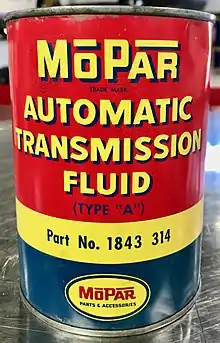
Chrysler, like many automobile manufacturers, uses transmissions sourced from other suppliers or transmission manufacturers around the world; these transmissions are not manufactured by Chrysler. Many of these automatic transmissions use unique fluids that might not be shown on this page.
Chrysler Automatic Transmission Fluids (ATF)
The original Mopar (MS-3256) transmission fluid was introduced in 1966. Over the years, the original specification was supplanted by Mopar (MS-4228), Mopar ATF+, Mopar ATF+2, Mopar ATF+3, Mopar ATF+4, and Mopar 8 & 9 Speed ATF, which is the latest fluid. Chrysler has upgraded the Mopar ATF specifications over the years; the newer fluids are not always backward compatible with previous fluids. Newer 6, 8, and 9-speed transmissions, as well as Plug-In Hybrid (PHEV) transmission technologies, require specialized fluids to operate properly. There remains a market for older fluids that claim to meet the earlier fluid specifications. See the details below for backward compatibility of each fluid.
1938 - Fluid Drive fluid
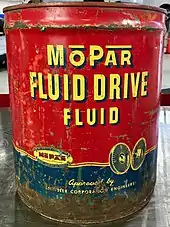
In 1938, for the 1939 model year, Chrysler offered the “Fluid Drive” in the Custom Imperial. This car had a three-speed manual transmission connected to a conventional clutch and clutch pedal system (Labeled Safety Clutch). The clutch pressure plate was connected to the engine through a sealed 2-element fluid coupling (A 1905 German Invention). Depressing the clutch pedal was not needed unless the driver desired to select a different transmission gear or reverse. A different gear would affect the acceleration rate and top speed.
The fluid coupling allowed the engine to stay running with the vehicle stopped and the transmission was still in gear. The fluid coupling was partially filled (80%) with a special Mopar Fluid Drive Fluid. This model was used from 1939 through 1941 on Chrysler and 1941 Dodge models. The transmission gearbox used regular S.A.E. 80 - 160 gear oil.
A revised Fluid Drive with a vacuum shifted 4-speed gearbox (the M3) was offered on Chrysler and Desoto models for the 1941 and 1942 model years. The M3 Fluid Drive also used Mopar Fluid Drive fluid in the fluid coupling but used regular S.A.E. 80 or 90 gear oil in the transmission. The M3 transmission was short lived as the U.S. was drawn into World War II in December 1941 and production was halted.
1946-1948 After the war, Chrysler offered the Fluid Drive and a new hydraulically operated 4-speed gear-box called the M5. The Fluid Drive used the special Mopar Fluid Drive fluid in the fluid coupling and the M5 transmission used a very light S.A.E. 10W oil. 1949-1953 Chrysler offered the Fluid Drive and a new hydraulically operated 4-speed gear-box called the M6. There were three variations of the M6, one used the previous conventional fluid coupling, the other two used a torque converter. The torque converter versions used motor oil rather than fluid drive fluid.
This fluid was first used in the fluid couplings of the following transmissions:
- 1939-1941 Fluid-Drive
- 1941-1942 M3 Fluid Drive
- 1946-1948 M5 Fluid Drive
- 1949-1953 M6 Fluid Drive
1953 - GM Type "A" fluid

It is important to understand that every automatic transmission produced by any vehicle manufacturer (Oldsmobile, Cadillac, Buick, Chevrolet, Pontiac, GMC, Ford, Mercury, Lincoln, Chrysler, Dodge, Desoto, Packard, and Studebaker used GM Type "A" transmission fluids in their transmissions from 1949-1958.
In 1949, GM released a new Type "A" fluid specification. In an attempt to make GM automatic transmission fluid available at retailers and service garages everywhere, GM partnered with the Armor Research Foundation for fluid and qualification testing. Fluids that met the GM qualification requirements were issued an Armor Qualification (AQ) license number of AQ-ATF-xxx. Example (AQ-ATF-101). The license number had to be displayed on the fluid container
In 1953, 14 years after GM released the Hydra-Matic 4-speed automatic transmission and its special Hydra-Matic Automatic Transmission Fluid, Chrysler released their first fully automatic transmission; the 1954 PowerFlite 2-speed transmission (for the 1954 model year). This new automatic transmission used the GM Type "A" automatic transmission fluid specification. Chrysler became a licensed reseller of the GM Type "A" fluid with an Armor Qualification number of AQ-ATF-600. The Type "A" fluid was sold under the Mopar brand name.
This fluid was first used in the following transmissions:
- 1954 PowerFlite 2-speed automatic transmission
- 1956 Chrysler TorqueFlite (A-466) 3-speed transmission
1957 - GM Type "A" Suffix "A" fluid
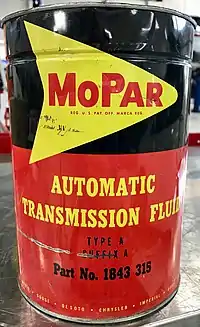
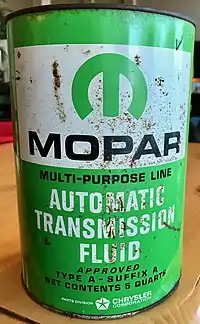
In 1957, GM released a new Type "A" Suffix "A" fluid specification. This fluid was better suited for the higher fluid temperatures caused by the unique torque converters and higher power engines of the day. The fluid specification was revised again in 1958, 1959, and 1960.
Chrysler became a licensed reseller of the GM Type "A" Suffix "A" fluid with an Armor Qualification number of AQ-ATF-2849A. The Type "A" Suffix "A" fluid was sold under the Mopar brand name.
This fluid was first used in the following transmissions:
- 1960 Chrysler TorqueFlite (A-904) (30RH) 3-speed transmission
- 1962 Chrysler TorqueFlite (A-727) (36RH/37RH) 3-speed transmissions
1966 - type MS-3256 fluid
In 1966, Chrysler released their own automatic transmission fluid Material Standard (MS-3256) and stopped using GM fluid specifications for many of their in-house transmissions. The Mopar MS-3256 fluid had GM Type "A" Suffix "A" characteristics.
This fluid is backward compatible with all Type "A" Suffix "A", and the Type "A" fluids produced from 1949-1966.
1968 - type MS-4228 fluid
_ATF_1978.jpg.webp)
_1978.jpg.webp)
In 1968, Chrysler released automatic transmission fluid Material Standard (MS-4228)[2] with GM Dexron (B) fluid characteristics. This upgraded fluid had improved low-temperature viscosity to provide for adequate shifting times in low temperatures. The fluid also had better oxidation resistance characteristics which resulted in longer fluid life. Chrysler became a licensed reseller of the GM Dexron(B) and the Dexron-II(D) fluids; they were marketed under the Mopar brand name.
This fluid is backward compatible with all Type "A" Suffix "A", and the Type "A" fluids produced from 1949-1966.
This fluid was first used in the following transmissions:
- 1968 TorqueFlite (A-998) (31RH) 3-Speed Automatic transmission.
1973 - ATF+ type MS-7176 fluid
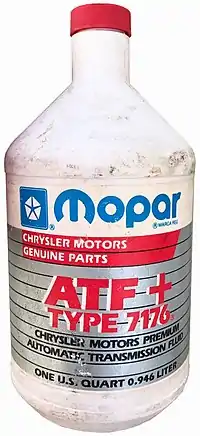
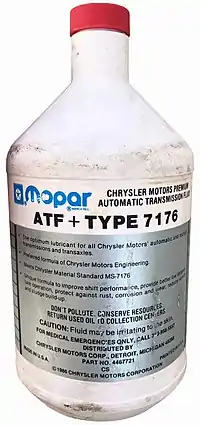
In 1973, Chrysler released the ATF+ automatic transmission fluid Material Standard (MS-7176) with GM Dexron fluid characteristics. This upgraded fluid had new oxidation and rust inhibitors to replace the previous sperm whale oil additive. The fluid also had better oxidation resistance characteristics which resulted in longer fluid life.
The plastic ATF+ and ATF+2 bottles were shaped like the existing brake fluid bottles of the day and ATF+ fluid was often accidentally poured into hydraulic brake systems by mechanics. The ATF+3 bottle was the normal shaped plastic oil bottle with the offset spout.[3]
This fluid was first used in the following transmissions:
- 1974 TorqueFlite (A-999) (32RH) 3-Speed automatic transmission
- 1978 A-404 3-speed automatic transaxle.
1980 - ATF+2 type MS-7176D fluid
As a result of the 1973 OPEC oil embargo and fuel shortages, the U.S. government created the Corporate Average Fuel Economy (CAFE) regulations in 1975. The regulations were to be fully implemented by the 1978 model year. The automotive industry responded by changing to three typically unused transmission technologies:
- A 4th gear (overdrive)
- A Torque Converter Clutch (TCC)
- Front Wheel Drive (FWD).
The introduction of the TCC led to customer complaints of a shudder while driving. All vehicle manufacturers made changes to their ATF specifications and the controls of their TCC to try and alleviate the problem. GM released the Dexron-II (D) fluid specification in 1978 and Chrysler released the ATF+2 fluid specification (MS-7176D) in 1980. This fluid is compatible with the previous ATF+ fluid, but not compatible with Dexron fluids (although you could use Dexron-II(D) in place of ATF+2). The ATF+2 and ATF+3 fluids were problematic and were withdrawn from the markets by April of 1998.[4]
This fluid was first used in the following transmissions:
- A-413 3-speed Transaxle (31TH) 1981
- A-470 3-speed Transaxle 1981
- A-670 3-speed Transaxle 1987
- A-604 4-speed Electronic Transaxle (40TE/41TE) 1989
- A-500 4-speed (40RH/42RH/40RE/42RE/44RE) 1988
- A-518 4-speed (46RH/46RE) 1992
1993 - ATF+3 type MS-7176E fluid
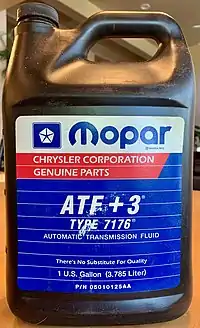
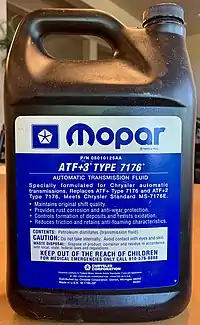
In the 1990s, Electronic controls of the transmission phased out the old hydraulic/mechanically controlled system. Chrysler and Toyota were first to market with electronic controlled transmission systems in 1988, Ford followed in 1989, and GM in 1991.
Electronic control of shift pattern (when does it shift), shift timing (how long it takes to shift), shift quality (shift feel), line pressure, and TCC apply and release rates were all affected by cold temperature performance of the ATF flowing through solenoids.
In 1993, Chrysler released the ATF+3 automatic transmission fluid Material Standard (MS-7176E) to help address the fluid needs of electronically controlled automatic transmissions. This fluid is compatible with the previous ATF+ and ATF+2 fluid, but not compatible with Dexron fluids (although you could use Dexron-II(D) in place of ATF+3). The ATF+2 and ATF+3 fluids were problematic and were withdrawn from the markets by April of 1998.[5]
This fluid was first used in the following transmissions:
- A-606 4-speed FWD (42LE) 1993
- A-618 4-speed (47RH/47RE) 1994
1998 - ATF+4 type MS-9602 fluid
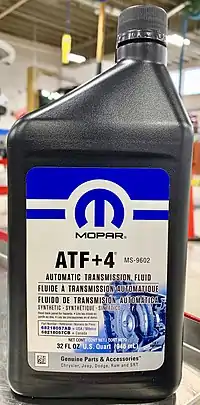
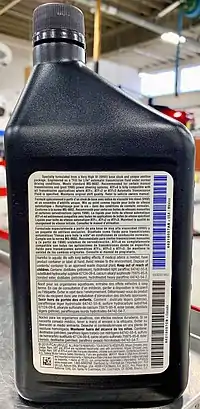
In 1994-1995, some early OBD-II phase-in vehicles experienced a P0300 DTC (Random Misfire). Engineers determined that road forces being transferred through the TCC were affecting the normal rotational fluctuations of the crankshaft and tricked the ECM into thinking there was a cylinder misfire. The solution was to create a new kind of TCC that would normally slip around 35 rpm.
- Chrysler called it the Electronically Modulated Clutch Control (EMCC)
- GM called it the Variable Capacity Converter Clutch (VCCC) and the Electronically Controlled Capacity Clutch (ECCC)[6][7]
- Ford used the slip technology but does not appear to have given it a unique name.
- Toyota called it the Slip Controlled Lock-Up Clutch (SCLC)
Other manufacturers had their own names. Some EMCC systems had a shudder or vibration during normal operation. Engineers tried several ECM/TCM calibration changes, but a revised fluid was also needed to address the issue.
- Ford released the new Mercon V fluid specification in 1996
- GM released the Dexron-III (G) fluid specification in 1998
- Toyota released the Type T-IV fluid specification in 1998
- Chrysler released the ATF+4 Material Standard (MS-9602) in 1998.[8]
The ATF+4 fluid is composed of a Texaco produced Extra High Viscosity Index (XHVI) Group 3 base oil plus an additive package developed by Lubrizol.[9] This fluid outperforms and outlasts the previous ATF+3 fluid Material Standard and was first used in some Chrysler mini-van transmissions in November of 1999. This fluid is considered a "Fill for Life" fluid by Chrysler. Do not confuse this fluid with Toyota's Type T-IV, they are not interchangeable.
The ATF+4 Type MS-9602 Fluid Material Standard was revised in 2003 (MS-6902 Change C) for the newly developed 6-speed transmissions. This fluid is compatible with the previous ATF+, ATF+2, and ATF+3 fluids, but not compatible with Dexron fluids. This was Chrysler's first "Lifetime" fluid with no fluid or filter changes required under "Normal" driving conditions.
This fluid was first used in the following transmissions:
- 40TE/41TE 4-speed 2000[10]
- 42RLE 4-speed 2003
- NAG1 5-speed 2005
- 40TES/41TES 4-speed 2007
- 62TE/62TEA 6-speed 2007
- 68RFE 6-speed 2007
- 65RFE 6-speed 2012
- 66RFE 6-speed 2012
2006 - CVTF+4 fluid
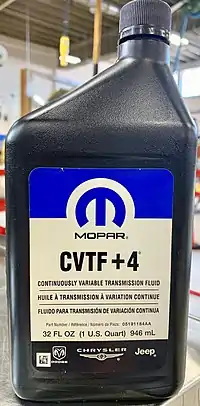
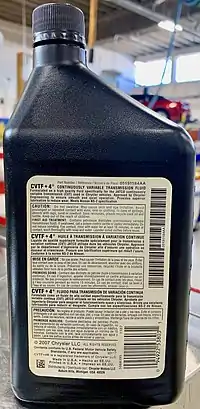
Beginning with the 2007 model year, Chrysler began using JATCO Continuously Variable Transmissions (CVT) in some of their vehicles; for example the 2007-2012 Dodge Caliber, Jeep Compass/Patriot. The Chrysler-approved fluid for the CVT is the CVTF+4 fluid. This fluid meets the Nissan NS-2 fluid specification. In 2015, Chrysler began phasing out the JATCO CVT and replaced it with the ZF 9HP 9-speed transaxle.
This fluid was first used with the following transmissions:
- JATCO JF010E CVT
- JATCO JF011E CVT
2008 - ASRC fluid
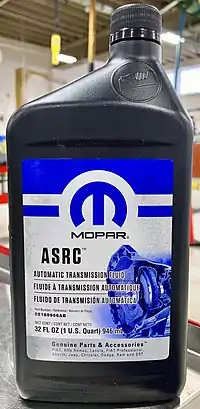
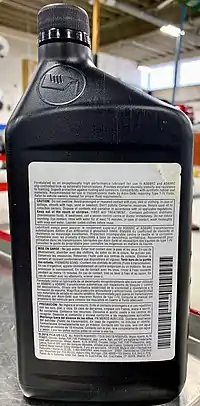
In 2008, for the 2009 model year, Chrysler sources Aisin-Sieki for 6-speed transmissions for use with the higher torque Cummins diesel engines. The ASRC fluid is required for these transmissions. The package rear panel reads "This fluid is recommended for use in transmissions made by Aisin-Seiki requiring Type T-IV fluids."
This fluid was first used in the following transmissions:
- 2009 AS69RC 6-Speed transmission with slip-controlled torque converter clutch
- 2009 AS68RC 6-Speed transmission with slip-controlled torque converter clutch
- 2013 AS66RC 6-Speed transmission with slip-controlled torque converter clutch
2013 - 8 & 9 speed fluid
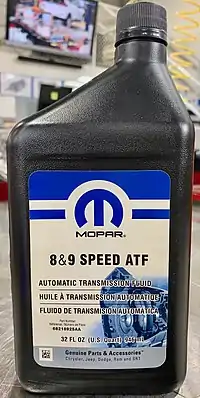
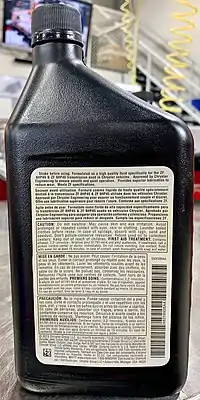
With increasing CAFE regulations, smaller engines with very narrow torque bands were being put in vehicles with 6, 8, and 9-speed transmissions. Chrysler sources Aisin for 6-speed transmissions with the Cummins diesel; ZF for 8-speed transmissions for RWD/4WD vehicles, and a 9-speed FWD/AWD transaxle for small SUVs. Special fluids are required for these vehicles.
In 2013, Chrysler adopted the ZF LIFEGUARD 8 fluid specification and markets it as Mopar 8 & 9 Speed ATF.[11][12] This fluid is not compatible with any other Chrysler or Dexron fluids.
NOTICE: Containers of ZF LIFEGUARD 8 fluid include instructions to "Shake before use"
This fluid was first used in the following transmissions:
- 2013 ZF-8HP70 8-Speed RWD w/TCC and Electronic Controls[13]
- 2013 845RE (Chrysler built ZF 8HP45) 8-Speed RWD w/TCC and Electronic Controls
- 2014 ZF-9HP45 9-Speed FWD w/TCC and Electronic Controls[14]
- 2013 948RE (Chrysler built ZF 9HP45) 9-Speed FWD w/TCC and Electronic Controls
- 2017 Si-EVT Hybrid-Electric Transaxle[15]
Chrysler "Lifetime" ATF
Example Maintenance Schedules
Lifetime automatic transmission fluids made from higher quality base oil and an additive package are more chemically stable, less reactive, and do not experience oxidation as easily as lower quality fluids made from lower quality base oil and an additive package. Therefore, higher quality transmission fluids can last a long time in normal driving conditions (Typically 100,000 miles (160,000 km) or more).
The definition of 'Lifetime Fluid" differs from transmission manufacturer to transmission manufacturer. Always consult the vehicle maintenance guide for the proper service interval for the fluid in your transmission and your driving conditions.
ZF 8-Speed Example
According to the Owner's Manual of a 2018 Dodge Charger with "Lifetime Fluid" and a ZF 8-speed automatic transmission, the automatic transmission fluid and filter never needs to be changed; however, ZF, the manufacturer of the ZF 8HP automatic transmission indicates the fluid has three different fluid service intervals depending on the driving style.[16] ZF recommends a transmission oil and filter change every 62,000 miles (100,000 km) or after eight years at the latest.[17]
1. Normal Driving ZF Automatic transmissions are maintenance-free and filled with specially developed partially synthetic ATF oils. Maintenance-free fills are intended for normal operating conditions.
- Under "Normal" driving conditions, the automatic transmission fluid never needs to be changed (See age restriction below).
2. Severe Driving Driving at very high operating temperatures can result in accelerated aging or increased wear of ATF oils. In the case of above-average operating conditions, such as:
- Driving with high transmission fluid temperature
- Frequent freeway driving in the upper-speed range
- Offensive or sporty driving style
- Frequent trailer operation (towing)
Under "Severe" driving conditions, it is recommended to refresh (change) the oil and filter of the automatic transmission every 62,000 miles (100,000 km).
3. Eight Years Old
- ZF recommends a transmission oil change after eight years at the latest.
6-Speed Example
A 2018 RAM 1500 with "Lifetime Fluid" and a 6-speed automatic transmission could have two different fluid service intervals depending upon how the vehicle is driven:[18]
1. Normal Driving
- Carry passengers and cargo within recommended limits on the Tire and Loading Information label
- Driven on reasonable road surfaces within legal driving limits
Under "Normal" driving conditions, replace automatic transmission fluid and filter every 120,000 mi (193,121 km)
2. Severe Driving
- Mainly driven in heavy city traffic in hot weather
- Mainly driven in hilly or mountainous terrain
- Frequently towing a trailer
- Used for high speed or competitive driving
- Used for taxi, police, or delivery service
Under "Severe" driving conditions, replace automatic transmission fluid and filter every 60,000 mi (96,560 km)
See also
References
- "ATF+4® Licensing Program". www.centerforqa.com. FCA. Retrieved 2019-02-01.
- Wagner, James C.; Kobe, Raymond A. (1968-02-01). "The Chrysler TorqueFlite and Automatic Transmission Fluid". SAE Technical Paper Series. 1. SAE International. doi:10.4271/680036. Retrieved 2019-02-01.
- Andrew Armstrong, Chrysler Corporation employee from 1953-1995
- Andrew Armstrong, Chrysler Corporation employee from 1953-1995
- Andrew Armstrong, Chrysler Corporation employee from 1953-1995
- https://patents.google.com/patent/US8292783 Method and apparatus for controlling a torque converter clutch
- https://www.sae.org/publications/technical-papers/content/2008-01-1584/ Aggressive Torque Converter Clutch Slip Control and Driveline Torsional Velocity Measurements
- "Chrysler transmission fluids: 7176, ATF+3, ATF+4". www.allpar.com. Retrieved 2019-02-01.
- Sumiejski, James L.; Skrobul, Anthony P.; King, Tracey E.; Florkowski, Dennis W. (1998-10-19). "Development and Introduction of Chrysler's New Automatic Transmission Fluid". SAE Technical Paper Series. 1. SAE International. doi:10.4271/982674. Retrieved 2019-02-01.
- Chrysler Technical Service Bulletin 21-18-99 Nov 5, 1999 Torque Converter Break In Information/ATF +4 Update
- "Lubricants and Oil Change Kits for Passenger Cars and Light Commercial Vehicles". aftermarket.zf.com. ZF Friedrichshafen AG. Retrieved 2019-02-01.
- https://aftermarket.zf.com/us/en/aftermarket-portal/passenger-cars-and-lcv/spare-parts-and-products/oil-and-oil-change-kits/ Oil and Oil Change Kits The Right Oil for your Passenger Car Transmission
- https://www.youtube.com/watch?v=FqyPizRyphQ ZF 8HP 8-Speed Automatic Transmission
- https://www.youtube.com/watch?v=A1U8hSIYa_c ZF 9HP 9-Speed Automatic Transaxle
- https://www.youtube.com/watch?v=rDPwQefY2KY The 2017 Chrysler Pacifica Si-EVT Hybrid-Electric Transaxle
- https://www.zf.com/serviceinformation ZF Service Information
- https://aftermarket.zf.com/remotemedia/lol-lubricants/lol-en/lol-te-ml-11-en.pdf Maintenance recommendations ZF automatic transmissions
- https://www.mopar.com/ramtrucks/en-us/care/owners-manual.html?openGarage=true OWNER'S MANUAL - 2018 RAM 1500
External links
- A Look at Changes in Automatic Transmission Fluid
- The History of Automatic Transmission Fluid - ATF History Part 1
- 67 Years of Chrysler (FCA) Automatic Transmission Fluid - ATF History Part 4
- Changing Gears: The Development of the Automotive Transmission
- Chrysler Service Information Subscription Access
- FCA ATF+4® Licensing Program